Actividad del volcán Reventador
07 de julio de 2014
El Reventador, situado en la zona sub-andina a 90 km al este de Quito, es uno de los volcanes más activos del Ecuador. Después de 26 años de calma el volcán entró en erupción en Noviembre de 2002 con una fuerte erupción (Índice de Explosividad Volcánica = 4), que produjo una columna eruptiva de 14 km de altura sobre el nivel del cráter. El colapso de la columna eruptiva produjo grandes flujos piroclásticos que llegaron hasta el pie de la caldera del volcán cortando la carretera principal y afectando el sistema de oleoductos del país. La pluma de ceniza volcánica se dirigió hacia el occidente provocando caídas de ceniza en Quito, lo que ocasionó el cierre del aeropuerto por varios días y serios problemas en la ciudad. Después del evento principal el volcán empezó a emitir flujos de lava de gran volumen. Desde el 2002 el volcán ha continuado manifestándose de manera diversa: con nuevos pulsos de actividad efusiva, con la generación de decenas de flujos de lava, y con pulsos de actividad explosiva, acompañada de explosiones de magnitud diversa, emisiones moderadas de ceniza y la ocurrencia de pequeños flujos piroclásticos. Los episodios principales de actividad se han producido durante los periodos de 2003, 2004-2005, 2007, y 2008-2010. A partir de inicios de 2012 se inicia un nuevo periodo con una actividad más persistente en el tiempo, la misma que sigue manteniéndose hasta la fecha de manera continua (Fig. 1) y que se manifiesta de manera similar a los períodos anteriores.
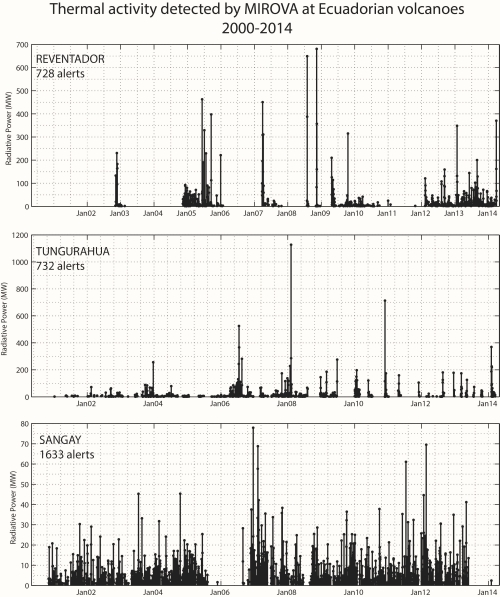
Figura 1: Diversos períodos de actividad en el volcán Reventador desde el año 2002, caracterizados por el número de anomalías termales detectadas por el sistema satelital MIROVA, notar su incremento y mayor continuidad a partir del año 2012 (Fuente: MIROVA)
Actividad actual
En los últimos días la actividad se caracteriza por la ocurrencia de numerosas explosiones, un promedio de 30 diarias en el último mes, las que en varias ocasiones se ha observado que dan lugar a la generación de pequeños flujos piroclásticos que descienden por los flancos del cono (Fig. 2), estas explosiones producen columnas de emisión de hasta 2 km de altura, con contenidos medios a altos de ceniza y que generalmente se dirigen hacia el W y NW del volcán. Por otro lado, aparentemente un nuevo flujo de lava fue detectado el 2 de julio, descendiendo por el flanco SSW del cono y extendiéndose por unos 400 m abajo del cráter interno del cono.
Sismicidad
El registro de la sismicidad en el volcán muestra que durante el mes de junio esta estuvo caracterizada por la presencia de señales de explosiones, de sismos de largo período (LP) y por eventos de tremor sísmico (Fig. 3). La sismicidad del mes de junio fue mayor en número de eventos que lo registrado en el mes de mayo 2014, algunos de estos eventos sísmicos tuvieron magnitudes iguales a o mayores a 3 y se ubicaron en los alrededores del cono (Fig. 4).
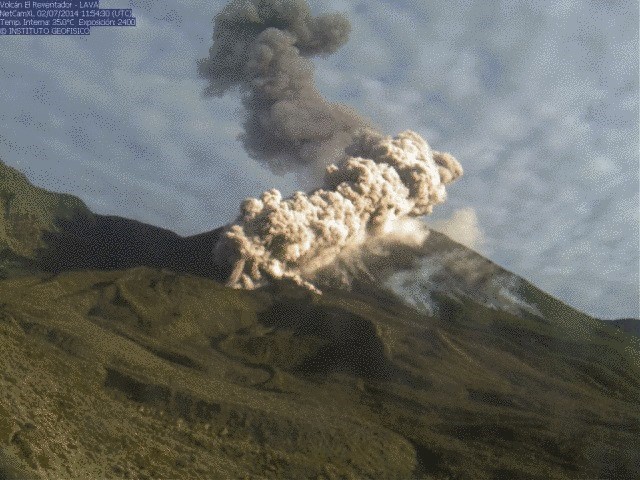
Figura 2: El 2 de julio, la cámara instalada en el sector de El Copete registra una explosión que dio lugar a la generación de un pequeño flujo piroclástico que se extendió unos 1500 m en el flanco S del cono, la columna de emisión, con un contenido moderado de ceniza se dirigió hacia el W.
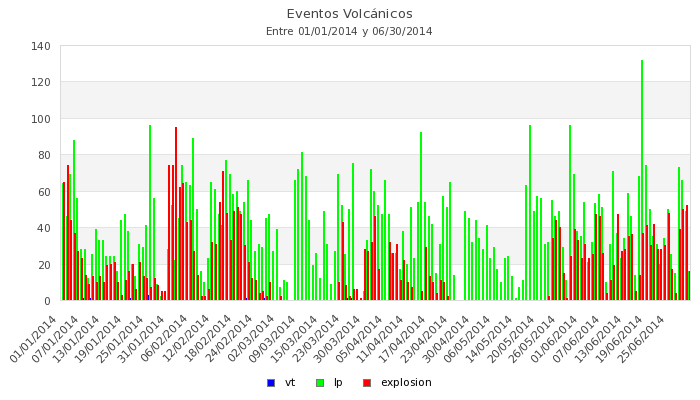
Figura 3: Registro de la sismicidad en el volcán Reventador, desde el 1 de enero al 30 de junio de 2014 (Fuente IG)
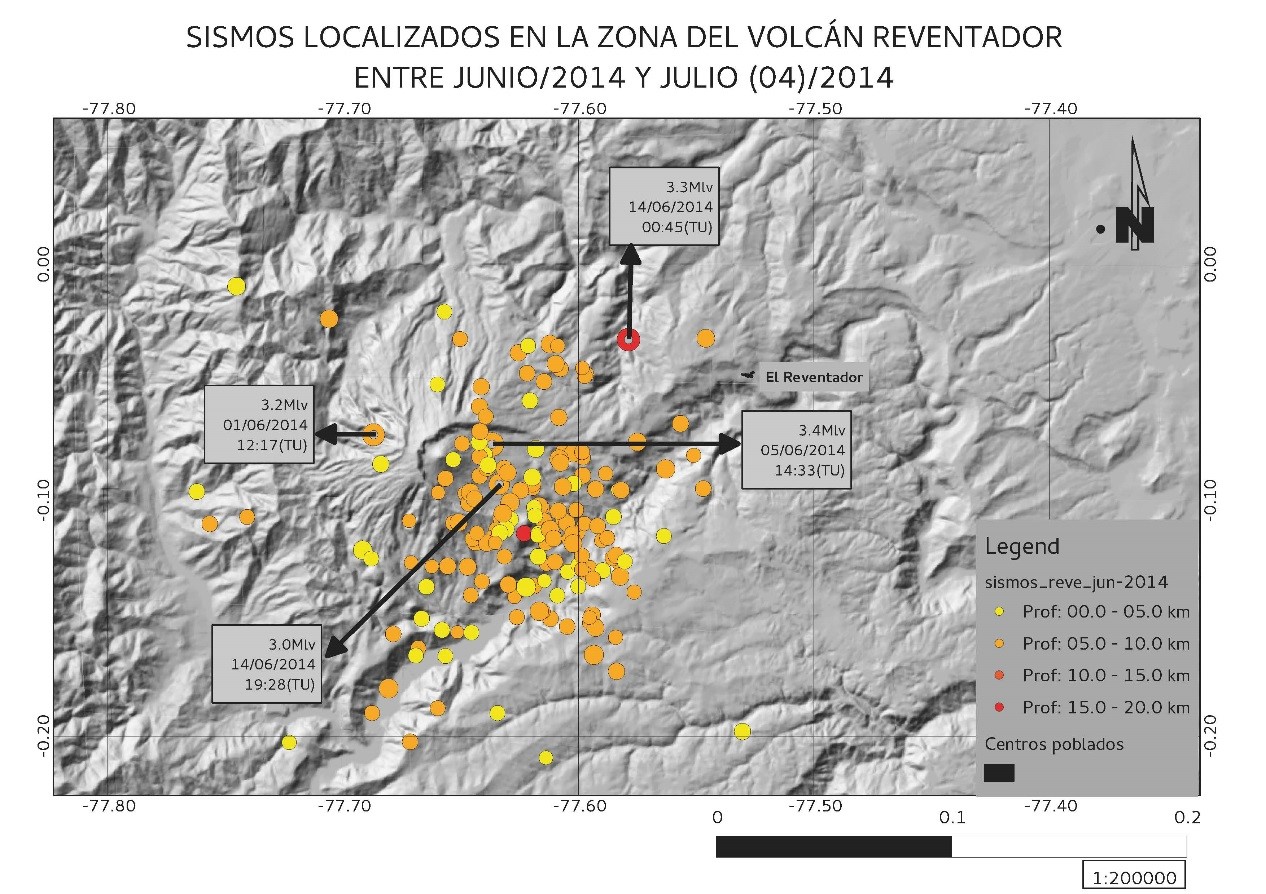
Figura 4: Ubicación de los sismos en los alrededores de la caldera del Reventador, desde el 1 de Junio hasta el 4 de Julio, 2014, los eventos con magnitudes de 3 o mayores se encuentran indicados.
Monitoreo térmico
La actividad del volcán también se ve reflejada por la cantidad de las anomalías térmicas que son detectadas por los sensores infrarrojos a bordo de los satélites Acqua y Terra, los que orbitan sobre el sector del Reventador 4 veces por día; el sistema MIROVA ha detectado en el pasado mes 11 anomalías termales, de pequeñas a moderadas (Fig. 5), la mismas que son coherentes con la sismicidad registrada y la actividad observada a nivel superficial durante el mes de junio. Las mediciones térmicas muestran que el tipo de actividad que al momento experimenta el volcán sigue una tendencia similar a lo que ha venido ocurriendo durante el último año (Fig. 5).
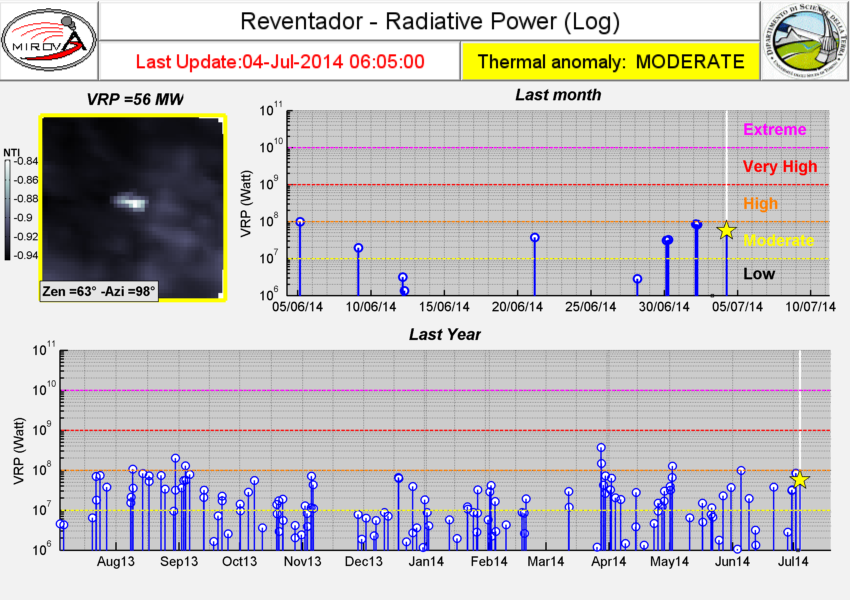
Figura 5: Registro de anomalías termales detectadas en el volcán Reventador durante el último mes (arriba) y durante el último año (abajo), de acuerdo a la información provista por MIROVA.
Escenario eruptivo
En función de la interpretación de los datos del sistema de monitoreo del volcán y en base al conocimiento de la actividad anterior del volcán, se estima que el escenario más probable para el desarrollo de la actividad del volcán, en el corto plazo, sería la continuación de los fenómenos ya experimentados durante el último mes, esto es, actividad explosiva constate y eventual actividad efusiva; un escenario mucho menos probable sería que la actividad se incremente sustancialmente y que los fenómenos descritos se vean magnificados en su intensidad y magnitud.
Los vulcanólogos del Instituto Geofísico efectúan simulaciones sobre la probable dispersión de la ceniza, usando el modelo Ash3D, provisto por el Servicio Geológico de los Estados Unidos (USGS); a manera de ejemplo se ilustra en la figura 5 una simulación de lo que podría ser la distribución de la ceniza, para un evento de tamaño moderado (VEI=3) que ocurriría el día de hoy. Para este modelo se usó una columna de erupción de 8 km sobre el cráter, en el cual la ceniza arribaría a la ciudad de Quito en un lapso de 2 horas y dejaría un pequeño depósito de ceniza menor a 0.1 mm de espesor (Fig. 6). Recordemos que durante la erupción de Noviembre de 2002 (VEI=4), el depósito de ceniza sobre la ciudad fue de unos 3 mm.

Figura 6: Simulación de la dispersión de ceniza para un supuesto evento eruptivo el día de hoy que tendría las características que se indican en el recuadro superior izquierdo de la figura.
Con objeto de efectuar mediciones de los depósitos recientes de la actividad del volcán, de efectuar monitoreo termal y de gases y de efectuar mantenimiento de la red instrumental instalada, los técnicos del IG han planificado efectuar una misión de campo al volcán, para lo cual se espera contar con el apoyo logístico de vuelos de helicóptero por parte de la Secretaría de Gestión del Riesgo (SGR), tal como ha sido en ocasiones anteriores. Sobre el desarrollo del proceso eruptivo del volcán en los próximos días, el Instituto Geofísico continuará enviando su información a las autoridades respectivas y a la comunidad.
PR/BB/PM/DP/MR
Instituto Geofísico
Escuela Politécnica Nacional












